| |||||||
| Anthem | "The Star-Spangled Banner" | ||||||
| Capital | Washington D.C. | ||||||
| Largest city | New York City | ||||||
| Other cities | Chicago, Baltimore, Philadelphia | ||||||
| Language | English | ||||||
| Religion main |
Protestantism | ||||||
| others | Roman Catholicism, Judaism | ||||||
| Demonym | American | ||||||
| Government | Federal Presidential Constitutional Republic | ||||||
| President | Joe Biden | ||||||
| Vice President | Deval Patrick | ||||||
| Established | July 4, 1776 | ||||||
| Independence | from Great Britain | ||||||
| Currency | American Dollar | ||||||
The United States of America (USA), commonly known as the United States, America, or the Union, is a large federal republic located in North America. It is bordered by Quebec, Canada, and Alyeska to the north, the Confederate States of America and Mexico to the south, and Pacfica to the west. On the east it is bordered by the Atlantic Ocean, and on the west it is bordered by the Pacific. The country consists of 45 states and one federal district.
The United States is one of most prosperous nations in the world. It became independent from Great Britain in 1783 after the American Revolutionary War, which was the first successful revolution against a European colonial empire. The US Constitution is the oldest and shortest constitution, and guarantees many civil rights and freedoms. Driven by the desire of Manifest Destiny, the United States attempted to expand across North America during the 19th century, results in conflict between America, Britain and other nations in North America. The American Civil War resulted in the independence of the Confederacy. World Wars I and II cemented America's role as a global military and economic power. Today, America is a global leader in culture, economics, military, technology, and science.
History[]
Colony and Independence[]

The Battle of Fort McHenry during the War of 1812
The United States was growing prosperous and restless. The British, angered at the loss of its colonies, looked for any way to halt American expansionism, while the War Hawks hoped for war with Great Britain and dominance of America on the continent. Following several incidents including skirmishes between the two nations' navies and Native Americans, the United States, under James Madison, declared war on Great Britain, beginning the War of 1812. The war had mixed results; on the positive, New Brunswick and Nova Scotia were added to the nation; on the downside, Indian and British raids had devastated western America, the British blockaded the coastline, grinding the economy to a halt, and in one terrible incident, the White House and other government buildings were torched. Still, Americans were satisfied with the results, resulting in the decline of the Federalist Party and the Era of Good Feelings.
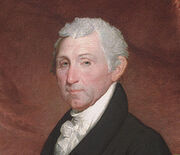
President James Monroe
Madison's successors, James Monroe and John Quincy Adams, enacted the Monroe Plan, which encouraged the growth of the economy, industry and infrastructure. All across the north, factories sprung up, new mines and schools were built, and roads connected the major cities. The first railroad system in the Americas connected Washington with New York. Railroads, along with new canals, increased the trade and productivity of the nation. James Monroe issued the Monroe Doctrine, which forbid European powers from creating new colonies in the Americas. However, America lacked a navy to back these claims up, and the European nations soon looked to South America to increase the size of their empires.
Expansion and Division[]
War hero Andrew Jackson was elected President in 1828 for the Nationalist Party and promoted the expansion of America and the decentralization of the American government. Jackson kept ties with Quebec and strengthened the two nations' alliance. Jackson also promoted the removal of Native Americans to Indian territories near
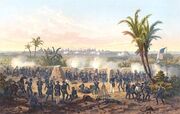
Battle of Veracruz, Mexican War
Texas, known as the Trail of Tears. Jackson's successor, Martin van Buren, would continue his policies, though the Panic of 1837 cost him re-election. At this time, Nationalists believed in the expansion of America across the continent. The goal was known as the Manifest Destiny. Nationalist candidate James K. Polk led the successful Mexican War of 1846, bringing Texas into the United States, and helped support the Republic of Pacifica. However, the Nationalists were opposed by the abolitionists, who feared that southern states would soon have greater power than the north because of the newly acquired Mexican territory. To counterbalance the Nationalists, the Republican Party was formed.
However, the ties between North and South were breaking, due to the "peculiar institution" of slavery, and states' rights. Arguments broke out between the industrial abolitionists of the north and the agrarian plantation owners of the south. President Millard Fillmore, after assuming the role when Zachary Taylor died, did little to defuse the situation. His Compromise of 1850 only managed to delay the fight. The Nationalist Party continued to promote expansion and industrialization, while free states and slave states argued. In 1856, the North managed to elect Republican John C. Fremont, a staunch abolitionist. Fremont failed to end the feud and relieve tensions and put pressure on the south to end slavery. Angered, the southern states seceded in late 1858, forming the Confederate States of America. Fremont declared secession illegal, and sent the army to put down the rebellion. But by that point, many officers had moved to the south to support the Confederacy, with thousands of southerners raising arms. In early 1860, the Confederates bombarded Fort Sumter, beginning the American Civil War.

The Confederate War of Independence
Despite the best efforts of the Union, the Confederacy managed the gain independence. Though they were outnumbered, outmanned and lacked in industry, the south made up for it with great generals such as Robert E. Lee and Thomas "Stonewall" Jackson, better soldiers, and the fact they only had to defend their territory and wait for a nation to recognize it. The Union managed to blockade the Confederacy, who needed to import materials and equipment. Fremont promised a quick end to the war, which led to re-election in 1860. However, the war soon became a stalemate, until Confederate troops managed to win a series of decisive victories in the north. This, coupled with rising tensions between the US and Canada and Pacifica, resulted in them declaring their support for the Confederacy along with the United Kingdom. The Royal Navy broke up the blockade, and Fremont was forced to call for peace and recognize the independence of the south in 1862.
Rebuilding[]
Fremont left the White House in disgrace in 1864, when the Nationalists, led by Andrew Johnson, came to power. Johnson's goal was to mend relations and appease the Confederacy and Great Britain, which met some success. Horatio Seymour continued his policies, with many of the country's citizens noticing his gentleness and appealing nature. However, this angered some citizens, who wished to have revenge on the Confederacy. In 1878, Congress became divided between the Republicans and Nationalists. In 1880, James G. Blaine defeated Samuel Tilden to become president. Blaine promoted a hardline approach to dealing with the Confederacy and England. Tensions boiled between the United States and England over the Oregon Territory, which the British claimed to govern.

War of 1885
Blaine used his hardline stance to win re-election in 1884. The following year, tensions boiled until war was finally declared. Although it possessed more industry and manpower, better Confederate generalship prevented the north from achieving an early victory. The British Royal Navy blockaded the coastline, while Pacific and Canadian soldiers poured in from the west, while the Confederates headed toward the capital. An American victory at Annapolis stopped the Confederates from reaching Washington, but it was clear that the Americans could not win the war. Blaine was forced to sue for peace, and the war ended in early 1888.
Industrialization[]
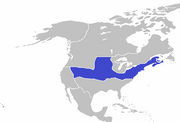
America following the War of 1885
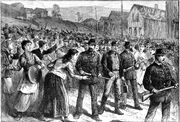
Pinkerton detectives during a strike
As a result of their defeat, America, now under Nationalist Grover Cleveland's control, focused on industrializing the nation. Fueled by massive immigration from Europe, a majority Irish and Italian worked in and built factories, mines, schools, and railroads. "The Gilded Age" was known for the poverty in the lower classes and wealthiness of the owners of massive companies, such as Andrew Carnegie, John Rockefeller, and J. P. Morgan. The hardships endured by the working classes resulted in attempts to unionize the workers and improve the standards of safety and living. Riots and violence would sometimes break out between the striking workers and the Pinkerton detectives hired by the companies. Attention to the living standards of workers would led to the creation of the Liberal Party, formed by Progressive former Republicans and unionists. On the other hand, radical movements such as anarchism was founded. Following the Panic of 1893, Cleveland would be kicked out of office, to be replaced with Liberal Party candidate William McKinley. McKinley attempted to protect manufacturers and factory workers from foreign competition and improving working conditions, but would be assassinated by anarchists a year into his second term.
His successor, Theodore Roosevelt, would focus on "prosperity at home and abroad". He focused on antitrust laws and broke up the monopolies held by the massive companies and gave attention to rights and protection of workers. He also worked to ensure America would not be defeated by the Confederates, and as a result he modernized the army, and worked on securing alliances. America would form a major alliance with France, as well ones with Quebec, Alyeska and Mexico in North America, and Argentina and Venezuela in South America. Philander C. Knox was the third Liberal Party candidate to be elected president in a row, and would continue the policy of his predecessors until the war to end all wars broke out.
World War I and the Roaring Twenties[]
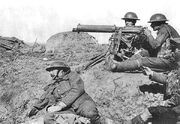
American soldiers in Virginia
The escalation of tensions in the Balkans had led to the outbreak of World War I in 1913. Knox believed that America wasn't ready for the war, but nevertheless rallied the nation to defeat the southern threat, as well as capturing northern California and reach the Pacific. A Confederate drive toward Washington was stopped, and the war devolved into trench warfare, during which an entire generation was devastated for small gains on the battlefield. Unlike the previous wars, the United States possessed better generals such John Pershing, and the support of the entire population. The industry soon outpaced the Confederates, and the Union armies pushed into Mississippi and Virginia, which forced the Confederates to sue for peace in 1919. The Treaty of Portsmouth forced the Confederates to give up Oklahoma and West Virginia to the United States and pay war reparations. Northern California was incorporated into America, finally giving the nation its western seaport.
The nation was not at ease, however. About 250,000 had lost their lives in the fighting, and the outbreak of the Spanish Flu killed thousands more. The Nationalists would return to the presidency with their candidate, Charles Evans Hughes. He would preside over one of the largest economic booms in American history. The memories of the war and "The Lost Generation" would be forgotten as the economy soared and jobs were plentiful. A new class of citizens with more money eagerly spent on cheap products that weren't available to them before the war, such as radios, telephones, automobiles, and motion pictures. Jazz rose in popularity and Art Deco peaked. Woman were given the right to vote, and they ensured that Hughes' successors, Nicholas Butler and Herbert Hoover, would be elected president in 1924 and 1928, respectively.
Great Depression[]

The United States, 1937
The prosperity of the Roaring Twenties was ended by the Stock Market Crash of 1930, which eventually to a worldwide depression known as the Great Depression. Unemployment skyrocketed to up to 25%, prices of goods fell, manufacturing rates plunged, and millions were thrown out of work. Nationalist President Hoover would be unable to handle the crises, resulting in him being replaced by Liberal candidate Samuel DeWitt in 1932. DeWitt set in motion his plan to end the depression through welfare programs, regulations, development, social security, and building trade unions. Massive infrastructure programs back in the east and in the Oregon Territory created new jobs, and unemployment decreased to around 11% in 1938.
The popular DeWitt would be re-elected and would continue to rebuild the economy, but the far greater issue during his second term was the rising power of the Confederacy, which had seen the rise to power of devoirist politician Hugo Black. Black moved troops into Tennessee, which was outlawed, however DeWitt decided to take no action against the Confederates. Black would then demand that Oklahoma be returned to the south. At the urging of his Liberal Congress, Dewitt decided to hold a referendum for the state to decide whether they would return to the Confederacy. An overwhelming majority agreed, and DeWitt would let Oklahoma return, on the condition they would not be re-militarized. Black agreed, and promised to end his territorial expansion. A few months later Black would break the agreement and Confederate troops entered Oklahoma.
World War II[]
The world would be ignited as the Second World War broke out in 1939, as the war between the Axis Powers and the London Pact raged across the globe. The war would lead to fears that the Confederacy and the Union would go to war once more, which led the the election of Franklin Roosevelt in 1940, who promised to take a harder stance against the south. Roosevelt demanded the Confederates withdraw their military and follow the Treaty of Portsmouth, which led to the Confederation invasion of the United States. Confederate attempts to launch a lightning campaign failed with the American defense at the capital, and a decisive victory at Pittsburgh.
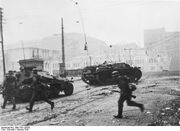
American soldiers in the Battle of Pittsburgh
American forces counterattacked in 1942, retaking Ohio and Indiana, and fighting off the Confederate campaigns in the east, which threatened the major cities in the area. Union troops would set foot on Confederate soil in 1943 and began its assault on the nation, with western troops cutting the link between Pacifica and Confederacy. General George Marshall led a devastating campaign across the south known as "The March to the Sea" which destroyed southern morale and their war effort. London Pact troops would conquer California in late 1944 and after conquering Richmond, American soldiers fought a bloody street fight in Atlanta in 1945, which led to the suicide of Black, allowing Confederate General Holland Smith to surrender in May 1945, ending the most destructive conflict in North American history.
Becoming a Superpower[]
Following the end of the war, the United States found itself one of the most powerful nations on earth. Many Americans were uncertain about this role, as Americans were used to being isolated from the rest of the world. President Joseph P. Kennedy continued to focus on the Americas, creating the American Occupation Forces, led by General Creighton Abrams, to pacify the conquered Confederate States until their eventually absorption back into the Union.










